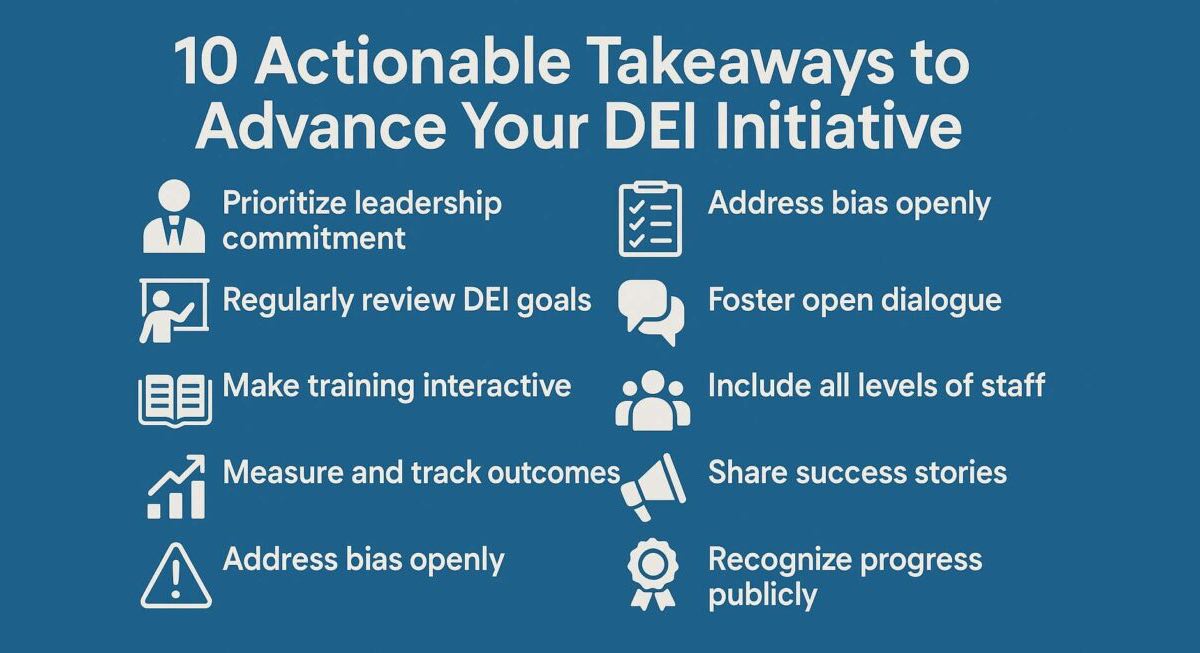Diversity, Equity and Inclusion Training: Building Stronger Workplaces Through Evidence-Based Learning.
The Australian workplace landscape has shifted dramatically over the past decade. We see organisations grappling with talent retention, employee engagement, and cultural transformation. Meanwhile, companies are setting transparent targets, goals, and D&I initiatives to increase accountability across leadership positions.
Diversity equity and inclusion training sits at the centre of this transformation.
But here’s what most organisations get wrong. They treat diversity equity and inclusion training as a one-off event rather than an ongoing strategic initiative. They focus on compliance rather than culture change.
They deliver generic content instead of tailored solutions that address their specific workplace challenges.
At 1Diversity, we work with Australian organisations to design and deliver training programmes that create measurable change. We understand that successful diversity equity and inclusion training requires more than awareness-building. It demands a systematic approach that addresses unconscious bias, builds psychological safety, and equips leaders with practical skills for inclusive leadership.
The difference shows in the results.

Why Traditional Diversity Training Falls Short
Most diversity programmes fail because they rely on outdated approaches. Companies often purchase off-the-shelf training modules that cover broad concepts without addressing specific workplace dynamics.
Employees sit through presentations about bias and inclusion but leave without practical tools for daily application.
Research shows that mandatory diversity training can sometimes backfire. When employees feel forced to attend sessions, they may develop resistance to the concepts being taught. This creates the opposite effect to what organisations intend. We also see organisations treating diversity equity and inclusion training as damage control.
They implement programmes after discrimination incidents or poor engagement scores.
This reactive approach misses the opportunity to build proactive cultures where inclusion becomes embedded in everyday practices.
The most effective diversity equity and inclusion training takes a different path. It starts with comprehensive organisational assessment. We examine existing policies, review demographic data, and conduct cultural surveys to understand current realities. This foundation enables us to design training that addresses real challenges rather than theoretical concepts.
At 1Diversity, we call this the diagnostic phase.
Core Components of Effective Diversity Equity and Inclusion Training
Unconscious Bias Recognition and Management
Unconscious bias training reduces bias in attitudes and behaviours at work, from hiring and promotion decisions to interactions with customers and colleagues. But recognition alone isn’t enough.
Employees need practical strategies for managing bias when it appears.
We teach participants to identify trigger situations where bias commonly occurs. These include performance reviews, recruitment decisions, team assignments, and client interactions. Participants learn to pause, question their initial reactions, and apply structured decision-making frameworks that reduce bias impact.
The training includes interactive exercises where participants examine their own bias patterns.
We use case studies drawn from real workplace scenarios to help people understand how bias influences daily decisions. Participants practice interrupting bias in others through respectful challenge techniques that maintain relationships while promoting fairness.
This hands-on approach works because it connects learning to real workplace situations.
Building Psychological Safety
Unconscious biases can make it challenging to build a truly inclusive and psychologically safe workplace. Psychological safety enables team members to speak up, share ideas, and admit mistakes without fear of negative consequences.
It’s the foundation upon which all other inclusion efforts rest.
Our training helps leaders understand their role in creating safe environments. We teach specific behaviours that signal openness and accessibility. Leaders learn to ask better questions, respond constructively to disagreement, and model vulnerability that encourages others to take interpersonal risks.
We also address the barriers that prevent psychological safety from developing. These include power dynamics, cultural differences, and historical experiences of exclusion.
Participants develop skills for navigating these challenges while building trust across diverse teams.
The outcome is teams where people contribute their best thinking without fear.
Inclusive Leadership Development
Inclusive leadership requires specific competencies that many managers lack. Traditional leadership training focuses on results delivery and team management but rarely addresses the complexities of leading diverse groups effectively.
We teach leaders how to adapt their communication styles for different cultural backgrounds and personality types.
They learn to recognise when team members may be struggling to contribute fully and develop intervention strategies that bring out everyone’s best work.
The training covers difficult conversation skills that enable leaders to address bias incidents, cultural misunderstandings, and inclusion challenges directly. Leaders practice these skills through role-play scenarios that simulate real workplace situations. This experiential learning approach builds confidence and competence simultaneously.

Cultural Competence Building
Australia’s workforce includes people from hundreds of cultural backgrounds. Each brings different communication styles, work preferences, and cultural values.
Diversity equity and inclusion training must address these differences constructively.
We help participants understand how cultural background influences workplace behaviour. This includes communication patterns, conflict resolution approaches, relationship building styles, and decision-making preferences. Participants learn to appreciate these differences rather than viewing them as barriers to overcome.
The training includes practical guidance for cross-cultural collaboration.
Participants discover how to structure meetings that work for different cultural styles, provide feedback that resonates across cultures, and build teams that leverage cultural diversity as a competitive advantage.
Designing Training for Different Audience Levels
Executive and Senior Leadership Training
In 2025, top executives will play a crucial role in promoting DEI efforts. Senior leaders need training that connects diversity and inclusion directly to business outcomes.
They must understand the strategic importance of inclusion and their personal role in driving cultural change.
Executive training focuses on systemic thinking about inclusion. Leaders learn to identify organisational barriers that prevent diverse talent from succeeding. They develop skills for making data-driven decisions about inclusion initiatives and measuring progress against meaningful metrics.
We work with senior leaders to create accountability systems that embed inclusion in performance expectations.
This includes setting diversity targets, linking inclusion outcomes to executive compensation, and establishing regular review processes that track cultural progress.
The training also addresses the personal dimension of inclusive leadership. Executives examine their own leadership style, communication patterns, and decision-making processes. They learn to model inclusive behaviours that cascade throughout the organisation.
Middle Management Training
Middle managers occupy a unique position in organisations. They translate executive vision into daily practice while managing the employee experience directly.
Their success with diversity equity and inclusion training determines whether senior leadership commitments become workplace reality.
We design middle management training around practical skill development. Managers learn to conduct inclusive recruitment processes, deliver performance feedback across cultural differences, and build high-performing diverse teams. They practice managing conflicts that arise from cultural misunderstandings and develop strategies for supporting employees from underrepresented groups.
The training addresses the specific challenges middle managers face.
These include balancing competing priorities, managing up and down simultaneously, and implementing inclusion initiatives while maintaining productivity. Managers learn to integrate inclusive practices into existing workflows rather than treating them as additional responsibilities.
We also equip managers with tools for recognising and addressing microaggressions, supporting employees who experience discrimination, and creating team cultures where everyone feels valued and included.
Employee-Level Training
Front-line employees need diversity equity and inclusion training that connects to their daily work experiences. The training must be relevant, practical, and immediately applicable to their specific roles and responsibilities.
We design employee training around interaction skills and cultural awareness.
Participants learn to work effectively with colleagues from different backgrounds, communicate across cultural differences, and contribute to inclusive team dynamics.
The training covers bystander intervention techniques that enable employees to address problematic behaviours they witness. Participants practice responding to offensive comments, supporting colleagues who experience bias, and escalating serious incidents appropriately.
We also address the personal benefits of working in inclusive environments. Employees learn how diversity and inclusion contribute to job satisfaction, career development, and workplace wellbeing.
Contact us here to discuss your training needs: 1diversity.com/contact-us.
Comparison of DEI, Diversity Training, Equity and Inclusion, and Inclusion Training
| Training Type | Primary Focus | Target Outcomes | Duration | Best For |
|---|---|---|---|---|
| DEI Training | Comprehensive approach covering diversity, equity, and inclusion together | Systemic culture change, policy implementation, measurable business outcomes | 6–12 months with ongoing reinforcement | Organisations seeking complete cultural transformation |
| Diversity Training | Understanding and appreciating differences in backgrounds, perspectives, and experiences | Increased awareness, reduced bias, improved cross-cultural communication | 1–3 months | Teams with low diversity awareness or recent bias incidents |
| Equity Training | Addressing systemic barriers and ensuring fair treatment and opportunities | Policy changes, process improvements, leadership accountability | 3–6 months | Organisations with identified pay gaps, promotion disparities, or systemic barriers |
| Inclusion Training | Creating environments where everyone feels valued, heard, and able to contribute | Improved psychological safety, team collaboration, employee engagement | 2–4 months | Teams struggling with participation, innovation, or retention issues |
Comparison of DEI, Diversity Training, Equity and Inclusion, and Inclusion Training
Training Type: DEI Training
Primary Focus: Comprehensive approach covering diversity, equity, and inclusion together
Target Outcomes: Systemic culture change, policy implementation, measurable business outcomes
Duration: 6–12 months with ongoing reinforcement
Best For: Organisations seeking complete cultural transformation
Training Type: Diversity Training
Primary Focus: Understanding and appreciating differences in backgrounds, perspectives, and experiences
Target Outcomes: Increased awareness, reduced bias, improved cross-cultural communication
Duration: 1–3 months
Best For: Teams with low diversity awareness or recent bias incidents
Training Type: Equity Training
Primary Focus: Addressing systemic barriers and ensuring fair treatment and opportunities
Target Outcomes: Policy changes, process improvements, leadership accountability
Duration: 3–6 months
Best For: Organisations with identified pay gaps, promotion disparities, or systemic barriers
Training Type: Inclusion Training
Primary Focus: Creating environments where everyone feels valued, heard, and able to contribute
Target Outcomes: Improved psychological safety, team collaboration, employee engagement
Duration: 2–4 months
Best For: Teams struggling with participation, innovation, or retention issues
Implementation Strategies for Maximum Impact
Pre-Training Assessment and Customisation
Effective diversity equity and inclusion training begins long before the first session. We conduct comprehensive organisational assessments that examine current inclusion levels, identify specific challenges, and understand cultural dynamics.
This assessment phase includes employee surveys, focus groups, policy reviews, and demographic analysis.
We examine promotion patterns, pay equity data, and employee satisfaction scores across different groups. This data informs training design and ensures relevance to organisational realities.
The assessment also identifies champions and resistance points within the organisation. We use this information to develop change management strategies that support training implementation and long-term culture change.
Multi-Modal Learning Approaches
People learn differently, and diversity equity and inclusion training must accommodate various learning preferences and styles. We combine face-to-face workshops, online modules, peer learning sessions, and experiential activities to create comprehensive learning experiences.
Interactive workshops provide opportunities for discussion, role-play, and skill practice.
Online modules offer flexible learning that employees can complete at their own pace. Peer learning sessions enable employees to share experiences and learn from each other’s perspectives.
We also use storytelling, case studies, and simulation exercises to make learning memorable and impactful. These approaches help participants understand complex concepts and remember key principles when they return to work.
Ongoing Reinforcement and Support
Training impact diminishes rapidly without ongoing reinforcement and support. We work with organisations to create systems that sustain learning and encourage continuous improvement.
This includes follow-up sessions that review progress and address new challenges.
We provide managers with tools for reinforcing training concepts during team meetings and performance discussions. Organisations receive resources for creating peer support networks and mentoring programmes.
We also establish measurement systems that track behavioural change and cultural progress. Regular surveys, focus groups, and performance metrics help organisations understand training impact and identify areas for continued development.
Measuring Training Effectiveness
Behavioural Change Indicators
Effective diversity equity and inclusion training produces observable changes in workplace behaviour. We help organisations identify and track key indicators that demonstrate training impact.
These indicators include changes in communication patterns, collaboration effectiveness, and conflict resolution approaches.
We measure participation rates in diversity programmes, employee resource group membership, and cross-cultural mentoring relationships.
We also track performance metrics that reflect inclusive practices. This includes improvements in team performance, innovation rates, and employee engagement scores across different demographic groups.
Cultural Climate Assessment
Training effectiveness shows in overall cultural climate changes. We conduct regular climate assessments that measure psychological safety, inclusion perceptions, and belonging levels across the organisation.
These assessments examine whether employees feel comfortable expressing different viewpoints, sharing personal experiences, and taking creative risks.
We measure trust levels between different groups and confidence in organisational commitment to inclusion.
The assessments also track incident reporting patterns, resolution satisfaction rates, and employee perceptions of fairness in organisational processes.
Business Impact Metrics
The best diversity equity and inclusion training connects to measurable business outcomes. We help organisations identify and track metrics that demonstrate the business value of inclusion investments.
This includes retention rates across different demographic groups, time-to-fill for open positions, and diversity in leadership pipeline development.
We measure customer satisfaction scores, market penetration in diverse communities, and innovation metrics that reflect diverse thinking.
We also track financial indicators such as reduced turnover costs, decreased legal risks, and improved brand reputation scores.
Common Implementation Challenges and Solutions
Resistance and Scepticism
Many organisations encounter resistance when implementing diversity equity and inclusion training. Some employees view the training as unnecessary, others worry about saying the wrong thing, and some resist changing established practices.
We address resistance through careful communication and inclusive design processes.
Training begins with business case presentations that connect inclusion to organisational success. We involve sceptical employees in programme design to address their concerns and build buy-in.
The training acknowledges different starting points and comfort levels. We create safe spaces for questions and concerns while maintaining clear expectations for respectful participation.
Resource Constraints
Organisations often struggle with the time and budget required for effective diversity equity and inclusion training. They may want comprehensive programmes but lack resources for full implementation.
We work with organisations to design phased approaches that fit available resources.
This might include starting with leadership training and cascading to other levels over time. We also provide train-the-trainer programmes that build internal capacity for ongoing delivery.
We help organisations identify creative funding sources, including government grants, industry partnerships, and cost-sharing arrangements with other companies.
Sustaining Momentum
Initial training enthusiasm often fades without ongoing support and reinforcement. Organisations struggle to maintain focus on inclusion while managing competing priorities.
We build sustainability into programme design from the beginning.
This includes creating internal champion networks, establishing regular review processes, and linking inclusion outcomes to performance expectations.
We also provide long-term support through consulting relationships, resource libraries, and peer learning networks that maintain momentum beyond initial training delivery.
Contact us here to discuss your training needs: 1diversity.com/contact-us.
The Role of Technology in Modern DEI Training

Virtual Reality and Immersive Learning
Technology is transforming how we deliver diversity equity and inclusion training. Virtual reality enables participants to experience workplace scenarios from different perspectives and practice inclusion skills in safe environments.
We use VR simulations to help participants understand the impact of microaggressions, experience unconscious bias firsthand, and practice difficult conversations without real-world consequences.
These immersive experiences create emotional connections that traditional training methods cannot achieve.
Artificial Intelligence and Personalised Learning
AI technology enables personalised learning experiences that adapt to individual needs and learning styles. We use AI-powered platforms to deliver customised content, track progress, and provide targeted feedback.
These systems identify knowledge gaps and adjust training content accordingly.
They also provide real-time coaching and support that helps participants apply learning in workplace situations.
AI analytics help organisations understand training effectiveness and identify areas for programme improvement.
Mobile Learning and Microlearning
Mobile technology makes diversity equity and inclusion training more accessible and convenient. We design mobile-friendly content that employees can access anytime, anywhere.
Microlearning approaches break complex topics into short, focused sessions that fit busy schedules.
Employees can complete brief modules during commutes, breaks, or other available time slots.
This approach increases completion rates and improves knowledge retention through spaced repetition.
Future Trends in Diversity Equity and Inclusion Training
Integration with Performance Management
We see increasing integration between diversity equity and inclusion training and performance management systems. Organisations are embedding inclusion competencies in job descriptions, performance reviews, and career development plans.
This integration makes inclusion a core business requirement rather than an optional add-on.
Managers receive training on assessing inclusion behaviours and providing feedback that supports inclusive practices.
Focus on Intersectionality
Training programmes are expanding beyond single-identity approaches to address intersectionality and multiple identity experiences. We help organisations understand how different aspects of identity interact and create unique workplace experiences.
This includes examining how race, gender, age, disability, sexual orientation, and other identities combine to shape individual experiences.
Training addresses the complexity of intersectional experiences and equips participants to support colleagues with multiple marginalised identities.
Emphasis on Allyship and Advocacy
Modern diversity equity and inclusion training places greater emphasis on allyship and advocacy skills. We teach participants how to use their privilege and position to support colleagues from underrepresented groups.
This includes speaking up against bias, amplifying diverse voices, and creating opportunities for colleagues to succeed.
Training covers the difference between performative allyship and genuine advocacy that creates meaningful change.
Getting Started with Professional DEI Training
Implementing effective diversity equity and inclusion training requires expertise, resources, and strategic planning. Organisations benefit from working with experienced providers who understand the complexities of culture change and have proven track records of success.
At 1Diversity, we bring deep expertise in training design, cultural assessment, and change management to every engagement.

We understand Australian workplace dynamics and regulatory requirements. Our team includes practitioners with diverse backgrounds who bring personal experience to their professional expertise.
We work with organisations of all sizes, from small businesses implementing their first diversity initiatives to large corporations seeking advanced inclusion strategies. Our approach combines evidence-based practices with practical solutions that fit organisational realities.
The journey toward inclusive workplace culture begins with a single step.
Training provides the knowledge, skills, and motivation that employees need to create environments where everyone can contribute their best work. When designed and delivered effectively, diversity equity and inclusion training becomes a catalyst for broader organisational transformation.
We invite you to explore how professional training can accelerate your inclusion journey. Our team stands ready to discuss your specific needs, assess your current state, and design programmes that deliver measurable results.
Contact us here to discuss your training needs: 1diversity.com/contact-us.
The time for action is now. Your employees, customers, and stakeholders are watching. Make diversity equity and inclusion training an investment in your organisation’s future success.
